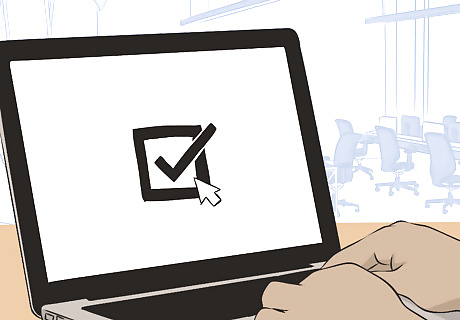
views
Planning the AI

Think about what problem your AI solves, and how it helps people. Your AI doesn't have to solve a problem, but more people will use it if it does. For example, does it help someone identify dangerous plants? Or does it help someone identify water that is unsafe to drink? The problem can be anything, it doesn't have to be serious. You could create an AI that can tell the difference between someone exercising or someone relaxing.

Think about how people will interact with your AI. Every AI has to have an interface, so people can more easily use it. For example, people use Google Lens through a camera based interface , and Siri via a microphone based interface.

Do research on the boundaries of the field of AI. You probably don't have the resources or education to create a complex AI like ChatGPT. Look up new advancements in AI using websites like Google or arXiv.

Consider legal or ethical problems. Even if your AI has good intentions, it might still be able to be used for doing illegal things. Does your AI do anything illegal? If so, you may want to think about changing your idea to avoid serious consequences, like fines or jail. What unwanted biases could your AI have, and how can you remedy them?

Write down your plan. You can write it anywhere or anyway you want, as long as you can read and access it. This will help you remember what your plan is. You can't be forgetting import
Collect Training Data

Collect training data online. Training data is information you use to teach an AI. What type of data you should collect depends on what you want your AI to do . For example, if you want to make an AI that can tell the difference between cats and dogs, look online for images of dogs and cats, and sort the images. You can use a dataset search engine like Google Dataset Search to find training data. If you are creating a sound model, ignore this part, because you cannot upload sounds that were not recorded using Teachable Machine.

Collect training data in the field. Try collecting the data in the places your AI will be used. This could be anything from asking family members to take pictures of their pets or recording bird sounds. Remember, don't trespass on people's property to collect training data.
Making the AI

Go to the Teachable Machine website. Select the type of model that makes the most sense for the AI you want to make. Choose image project if your AI classifies images. Choose pose project if your AI classifies poses. Choose audio project if your AI classifies sounds. Teachable Machine only supports these types of projects , so if you want to make an AI that doesn't classify one of those things, you can't use Teachable Machine. Tensorflow or ml5.js are good options, but they require programming.

Add the number of classes you wish for. Click on the 'Add a class' button to do this. If your AI classifies cats and dogs, you need 2, the default. Don't add anything if this is the case. If it classifies cats, dogs, and pigs, you need 3, so press the button once. With sound models, remember, one of the classes is for background noise.

Name your classes and add training data. You don't have to name your classes, but you might get confused if you don't. You can upload the training data, or add it using your microphone, or any combination of the two!

Press the 'Train Model' button to create your AI, and wait until training is over While you wait, remember that your AI is getting better by the second! This probably won't take much time, unless you added extra training cycles.

Test your AI in the 'Preview' window. If it isn't working well, try collecting more training data. Add more training cycles by clicking on 'Advanced', and upping the number of epochs to your liking. It will take more time, but your AI will be better. Use data you didn't train your AI on for testing. Ask other people to test your AI!
















Comments
0 comment